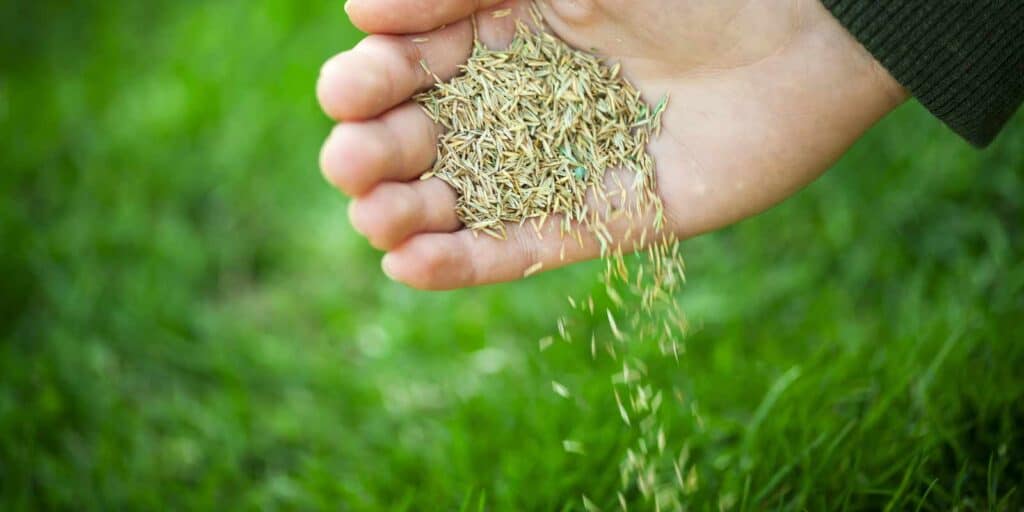If you live in Georgia or another southern state, you can count on the appearance of fire ant mounds in the year's late spring. To be such tiny little pests, ants can cause a lot of turmoil in home lawns, hayfields, and pastures. They are one of the most detested insects. Many people are stung […]

Overseeding Bermuda Grass
If you are looking to create a great tall fescue lawn this is how I (a lawn care nut!) would do it. First off choose your spot and dig the area out until you can see soil level. If needed add some topsoil or sand depending on what type of grass that you want to grow. Now use an old trowel blade to cut down each side of where you will be planting the seed. Make sure you leave at least an inch or two between each row so they don't touch one another. Use a garden rake to make 3 inch deep holes and 2 square feet apart all around the perimeter of the plot (this should take about 10 minutes). Then go ahead and start spreading the Fescue seeds by hand or with a seed spreader over the entire area leaving enough room since most Tall Fescue seed will fall back into place once disturbed. You may need to water them when first starting but not right away.
It's best if you wait 24 hours before putting any complete lawn fertilizer on the grass because it could burn it. The next day put 1/8 cup of nitrogen per square foot along with some slow-release granules like Miracle Grow. Another good idea is to spread a little more than normal just to ensure coverage. After these steps continue mowing as usual while using a leaf blower to blow the loose dirt towards the center of the patch making it look even better. When finished repeat step 5 again. This time uses a larger trowel blade and makes bigger rows which should only take five minutes. Repeat this process every year for years to come.
The following are some helpful tips to keep in mind when overseeding Bermuda.
Steps In Overseeding Bermuda Grass Lawns with Fescue:
- Mow Bermuda lawns regularly throughout the summer months.
- Water Bermuda lawns frequently through dry spells.
- Apply fertilizer in early spring and late fall when it is cool and not too cold such as in the winter months.
- Don't let weeds get too thick.
- Try cutting them carefully.
- Use weed block fabric mulching material.
- Cut it into pieces no wider than 6"x6".
- Spread evenly across the turf.
- Wait 4 weeks then remove.
- Reapply to lawns at a minimum of once a year, recommended twice yearly.
- Keep lawn damp. Don't allow beds to become soggy.
- It will encourage lush growth.
- Grasses have shallow roots and therefore require ample moisture.

Overseeding Bermuda With Other Types of Seeds
Overseeding Bermuda works well with other types of grasses as well. Just remember to follow the same procedure as above. Here is information regarding different types of grasses.
There are many kinds of grasses available today ranging from warm-season varieties such as Zoysia, Bahus, Centipede, etc., cool season grass variety such as Blue Streak, Tall Fescue lawn grass, etc., and perennial ryegrass seed and annual ryegrass seeds. Each variety has its advantages and disadvantages. For example, zoysias are very drought resistant but tend to shade their root systems deeper than others so must receive adequate sunlight. Cool season grass varieties are often used because they are less expensive to purchase and install. They also require much less maintenance and upkeep. However, there are times when cold weather restricts their usage. Perennial Ryegrasses are becoming increasingly popular due to their ability to withstand heavy snow loads, extreme heat, and humidity. Many people prefer to mix various types of grasses together to achieve maximum results to get a green-looking lawn year-round.
I highly recommend you try to find local sources who sell healthy organic seeds. These people know exactly what goes into quality seed development. There are many companies that sell cheap imported seeds that cannot compare to locally grown ones. Also, beware of certain companies who claim that their products are genetically engineered. Genetically modified grasses may contain pesticide residues and herbicide resistance. So basically buy organically produced grass that comes from reputable suppliers.
Fescue Grass
Fescues are classified under the genus "Festuca." Festuca is native to temperate climates worldwide but thrives best in cooler areas. Most fescues are blue-green shades although yellowish colors are seen occasionally. Their leaves are usually flat, thin, and long-reaching up to 12 feet in height. Some species can reach heights greater than 30 feet!
Proper Time of Year
Many commercial growers harvest new shoots from August to September each year before the winter. During hot summers in the summer heat conditions, harvesting can help reduce excessive vegetative growth and promote flowering. This is the best time window for overseeding. Harvesting later allows for taller grass stands without shading younger plants beneath. A few common cultivars include 'Brentwood,' 'Blue Mist' and 'Cascade'. All of these offer excellent grazing qualities.
Why Choose Fescue to Mix with Bermudagrass?
Most commonly referred to as Tall Fescue, this choice is suitable for most green lawns in almost any region. Its adaptability makes it ideal for large properties and natural landscapes alike. With proper management, it can provide exceptional performance both in durability and aesthetics. Fescue is known for its fast establishment rate and low requirements for irrigation and fertilization. Its tolerance to high temperatures and poor soils means that it can survive virtually anywhere - including urban environments. And, unlike traditional sod, Tall Fescue doesn't shed blades, meaning that it requires minimal labor during installation and maintenance. Finally, consider how easy it is to maintain the turf. Unlike traditional sod, Tall Fescue does not have to be replaced annually. This saves money and keeps waste to a minimum. Additionally, Tall Fescue has been shown to perform equally well in fields with pH levels as low as 5.5. Lastly, Tall Fescue offers numerous aesthetic options. Choices range from rich dark brown hues to golden straw tones.
So now we understand why we chose this particular grass and hopefully helped you learn something useful. We hope our experience helps you avoid mistakes made during the past several decades. Please feel free to contact us if you ever have questions or concerns.
Mowing and Lawn Care After Overseeding Bermuda
Lawns should be mowed at least once every two weeks after overseeding Bermuda. The first time will allow the grass to establish itself and grow out. Mowing grass between 2-4 inches should then occur approximately one week after the initial mowing. Once established, mow the grass about 3-6 inches depending on your preference. You'll want to keep the lawn looking fresh and green all summer long. If you live in an area where rain is scarce, you might need to water the grass more frequently to ensure that the grass roots remain healthy. In addition to watering, you may also wish to apply fertilizer. It's important to use a balanced fertilizer according to the manufacturer's recommendations. Remember, you don't want to overfeed so make sure to follow the instructions carefully.
Overseeding Bermudagrass with Fescue has plenty of advantages to give you a green-looking lawn. We wish you continued success with your lawn care!
